How To Handle Change In An Organization
In that location are quite a few change management models out in that location. The almost popular ones differ, sometimes quite significantly, and their success depends on many factors. For example, how does the organizational structure affect modify? Is the company very clearly departmentalized with teams working in very dissever silos? What motivates people and what discourages them? Are there barriers to immediate and clear communication caused by linguistic communication or cultural differences?
Companies too need to remember that centralization of power can help with an initial decision regarding alter, but it may hinder any recurring updates. On the other hand, a wider span of control can also exist problematic because it's hard for 1 manager to accept meaningful conversations most change with 50 people. Depending on each organization's existing culture, size and structure, in that location are differences in how suitable different alter direction models would exist and the last option should be carefully considered.
Four of the most pop alter management models are Kotter'south 8-step Program, Lewin's Change Management Model, The McKinsey 7S Model and the ADKAR Model. They all overlap in some aspects but differ significantly in others, so information technology's important to determine what suits your organisation's needs.
For instance, Kotter focuses on leadership driving the change, Lewin addresses the driving and restraining forces for modify, McKinsey requires leaders to look at both the business concern and people elements of alter, and ADKAR focuses on leader-driven goals.
Large organizations that understand the importance of leaders might want to consider Kotter, McKinsey and ADKAR. When planning for resistance, Kotter, Lewin and ADKAR might be the way to go. Kotter provides steps for implementation while Lewin and ADKAR are more general in their approach, encouraging organizations to develop their own fashion of reaching goals.
Beneath is an overview for each model, Kotter's 8-footstep Programme, Lewin's Change Direction Model, The McKinsey 7S Model and the ADKAR Model, followed by data on what to consider when deciding on a plan that's right for your organization and the role of feedback loops.
Kotter's 8-step Program

Quick overview
- This plan is an in-depth model that provides clear steps.
- It can be fourth dimension consuming, but long-lasting change needs preparation and time.
- Because of its peak-downwards arroyo, it might make those in accuse forget to allow time for feedback from all employees.
- The first 2 steps are a corking forcefulness of this plan considering many organizations don't take seriously the need to convince frontline workers that there is a need for alter. They just inform them that ane is coming, just engaging people in the change can be a true guiding force.
- This is a smashing model for large organizations and/or very pregnant changes.
This is ane of the most common and recommended models. Kotter's eight steps are:
ane. Institute a sense of urgency
Make certain that your people desire the modify because, for it to exist successful, they should believe that it needs to happen and that it'south urgent. Including employees in honest conversations virtually problems in the company tin can brand them more involved and engaged. And getting support from customers or outside stakeholders could aid with edifice a strong case for change.
2. Create a guiding coalition
Build the correct team with people who volition exist empowered to aid you. Search for leaders (even if they're non in managerial positions) and key stakeholders. If your arrangement is big, every department and every level within the organisation should take someone to represent them on the team. This will help build support throughout the company. Ask your team for an emotional commitment and make sure you work on team edifice. And don't be conceited well-nigh looking for weaknesses in your coalition. Is at that place something else you lot need? Is anyone missing? Does anyone need to be replaced?
three. Develop a vision and strategy
Make sure everyone is on the same page by having the right vision—everyone should run across the same time to come. A "vision speech"—a summary based on the values that are cardinal to the change and that capture the expected futurity—should exist skilful and delivered often. The alter coalition should also exist able to describe the vision in very few words. So consider developing straightforward answers to several questions: What are we all working towards? How tin we motivate each other? So develop a strategy to figure out the steps needed for this change to happen.
4. Involve everyone and enlist a volunteer army
Communicate, communicate again, and then communicate some more than. Projects frequently fail because of communication issues. Talk oft most your change vision to make sure everyone knows why you're making the modify, what the benefits volition exist and what the alternatives would be if the modify doesn't happen.
Allow people to share their concerns with you without fearfulness of retribution, and accost those concerns openly and honestly. The more people believe in it, the larger your support and you'll have a volunteer army at your disposal. What's more, y'all should tie your vision to all aspects of operations and lead by example preaching the change and living it.
5. Removing and reducing barriers
Make certain it'due south articulate whose responsibility it is to carry out any new deportment. Empower the change leaders by removing barriers (homo, organizational, etc.). Are your organizational structure, job performance and compensation systems in line with your vision? Are there whatsoever inefficient processes or illogical chains of command? People demand to be able to piece of work across departments and silos to generate real change.
Consider organizational rewards and recognize people for making change happen. Merely also keep an heart out and identify people who are resisting the change. They will demand your team'due south help to meet that modify is needed.
six. Generating and focusing on short-term wins
If you're tackling a very big change or task, separate it upwardly into small pieces, and celebrate completing each one along the fashion. When they're recognized and communicated, the whole organization will be able to track your progress and remain committed.
Make sure to find easy-win, cheaper projects to get-go with. Ideally, they should exist ones that you can tackle and implement without help from any potent critics of the alter. This is practiced advice regardless of what model an organization chooses. Starting with a pocket-sized, uncomplicated change helps people go a feel for how things work out, what change looks like and what challenges they might face.
7. Keeping the momentum going
Proceed building momentum and, after every win, analyze what went right and what needs piece of work. Focus on continuous improvement. Bringing in new people into your modify coalition can assistance proceed ideas fresh. Go on revisiting the steps that withal demand to exist completed to see if they can be improved or if they'll be affected by the completed steps in ways you lot haven't considered.
8. Anchoring new approaches in the culture
You need to make clear the connectedness between the desired new habits and organizational success. Brand it personal if possible. Include this connection in your organization's established procedures, mission and/or vision statement, constitution and new rent training. Stay on elevation of it considering it can be easy for people to revert to their old practices.
Talk nigh progress and share success stories whenever you can, publicly recognizing key contributors to change.
Lewin's Modify Direction Model
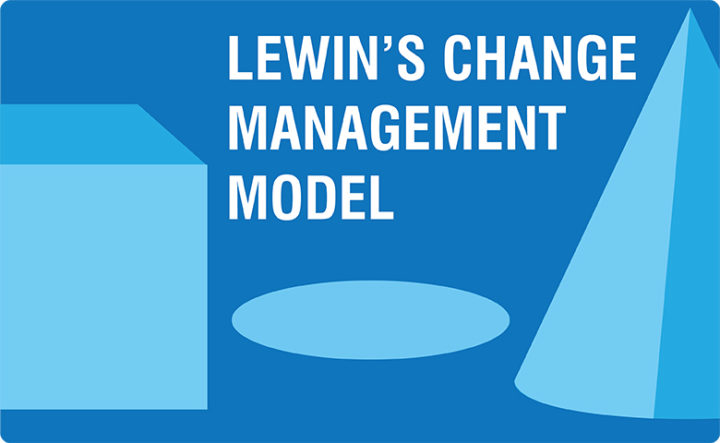
Quick overview
- This model is piece of cake to understand and provides a visual representation of what change should await like.
- Information technology does non talk over the detailed "how" of the alter, especially when it comes to dealing with situations that involve resistance from people who are against the alter.
- The model is simple, simply the implementation may be harder than it seems. It might work as a guideline for organizations that are prepared to dive into details on their own. Or information technology tin work in tandem with Lewin'due south Force Field Analysis.
This process aims to aid organizations understand what successful changes and transitions wait like while letting them effigy out how to attain them. And this comes in three stages:
1. Unfreezing
The "unfreezing" relates to the organization's condition quo. To change, everyone should understand the plans ahead and why a modify is needed. This is why leaders demand a compelling message that will make people believe in the importance of the change. The more the employees experience the urgency, the quicker the current state of the system tin can exist "unfrozen" and changed.
two. Changing
This is the implementation stage. Training and communication are crucial to help employees learn the new processes or behaviors and accept the changes. Rumors and negative perceptions demand to be addressed immediately and employees need to experience involved in the process. Education, fourth dimension and support are needed at this stage.
3. Freezing/Refreezing
This phase involves reinforcing and solidifying new processes and structures. The new land needs to become part of the culture and requires means of sustaining and supporting it in the long term. This is visually represented equally the new land being "frozen" as the new condition quo.
McKinsey 7S Model
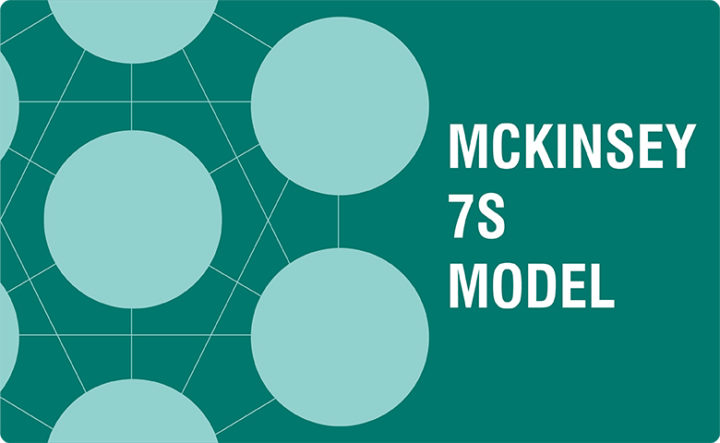
Quick overview
- This model is non a alter direction plan. It does not requite you steps that will help you improve each of the vii factors or strengthen your processes. Information technology's more of a preparatory-piece of work model than a alter model.
- Before creating an actual plan, this model is meant to assistance yous take 7 factors into business relationship and analyze the differences between where your arrangement is (electric current state of the seven factors) and where you want it to be.
- The model oftentimes drives dwelling the complexity of any organization because it shows that all those factors are so closely interrelated that if i is affected, it volition probably impact all the others. It helps leaders see what they demand to continue in heed when implementing change.
- A lot of work, research and benchmarking is required.
This model can help leaders assess every component of their organization in detail earlier they focus on action. Knowing exactly how all the parts of their arrangement are interconnected can help people understand how well-positioned the company is to ameliorate and deal with the intended modify. There are seven every bit-important and interconnected factors that need to be analyzed:
ane. Strategy
This is where companies clarify their objectives, strategy, and how they volition adapt in the future. In brusque, what's your programme to succeed in the marketplace? You have to identify problems that need addressing and create a plan of action to tackle them.
2. Structure
Leaders need to analyze the organizational structure and how everything within that construction, including people, activities, coordination and mechanism, fits together. They demand to look into the challenges (and chances for growth) that this structure will offer when change is implemented.
three. Systems
This is all about analyzing everyday processes and activities (including the people who undertake them, the tools they use and the resources allocation) and how they would exist affected past change.
iv. Shared Values
Equally the proper name suggests, these are the core values of the organisation. They influence all aspects of the company and impact all people and systems. Leaders need to figure out if these values tin reinforce the alter and what the organization is trying to achieve. If they can't, mayhap it's fourth dimension to reevaluate them. And if those values are only important on paper but don't permeate the organization, then that will get obvious very apace.
5. Way
Consider the organization's behavior patterns—or the "manner". These are the informal rules that are demonstrated by key leadership groups. Do they walk the talk? Do they actually embody the shared values? Analysis of the typical behavior patterns can help predict the way in which leaders will adopt, implement and champion changes to come.
six. Staff
This gene is all about the employees. What'south the makeup of the workforce? What are their roles, attitudes, characteristics and capabilities inside the organization? How are they trained and led? How will they react to changes and how will they be afflicted?
vii. Skills
When it comes to analyzing skills, this covers not only the core competencies of the employees but also the capabilities of the organization equally a whole. What are the core skills and what can/should be outsourced?
ADKAR Model
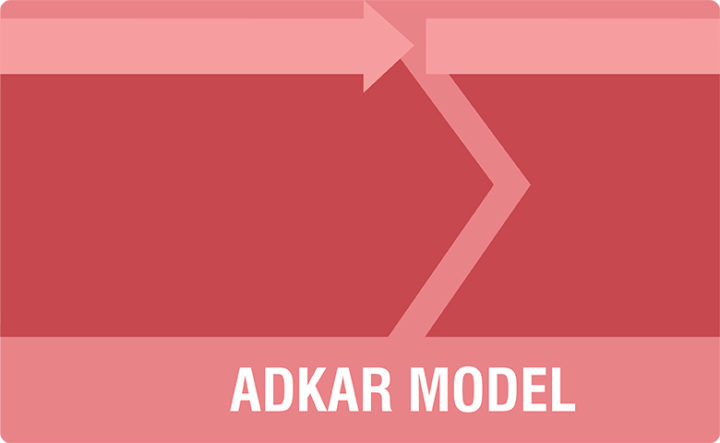
Quick overview
- This model is not platonic for companies that are not certain most the telescopic of the transitions they need to face up.
- It is focused on goals rather than the path towards them, so it can be an adaptable tool that fits many types of organizations.
- Larger alter might non be something to tackle with this model.
This model outlines the goals—instead of steps—that leaders should aim to achieve when implementing alter.
1. Sensation
Creating awareness relies on a stable line of communication with employees. Everyone needs to sympathize the benefits of the modify and why it'south needed.
2. Want
Being aware of changes doesn't mean that employees will desire them, so leaders need to create a want for change and for the resulting benefits.
3. Cognition
This is most educating yourself AND sharing knowledge with the employees. Plant what the pros and cons of the modify will be, and what the potential barriers might demand to be overcome. And openly share everything there is to know with the employees with detailed instructions instead of a summary.
4. Ability
You need to ensure that the organization fosters an environment that enables people to work through the modify. Will your company exist able to deal with the modify and will employees exist able to conduct out their tasks? Will they demand additional assistance or educational activity?
5. Reinforcement
Sustained change will require reinforcement. Mistakes demand to be handled with care and leaders should proceed the engagement, dedication and momentum going. Everyone will need admission to tools that will help them stay on track.
Which Alter Management System to Choose
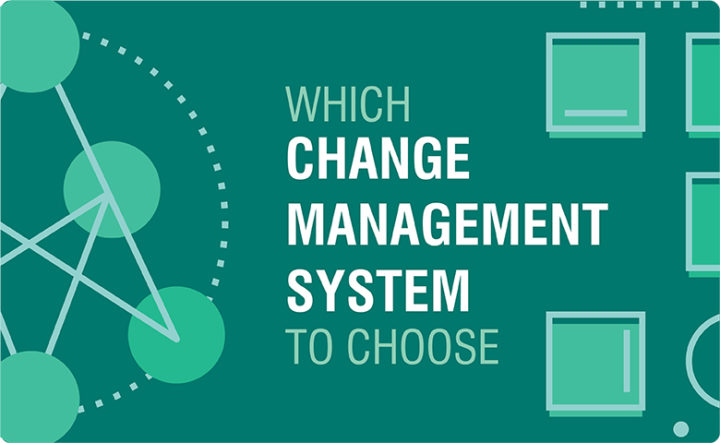
Whichever change management organization you lot decide to utilize, execute the change model with care, quality and structure. Don't recall that because this is an internal entrada, information technology doesn't deserve the aforementioned level of dedication as customer-facing initiatives like a product launch, marketing campaigns or a CEO speech in a public forum.
In fact, it volition need to be tackled with even more care because employees can be your toughest critics and they have the greatest historical baggage, understanding and involvement. Exist sure to use your best talent to write and pattern internal speeches, campaigns, stories, and develop collateral. Apply your best speakers to evangelize and share the information and include key people for early adoption.
And stick with your selection for future changes. This manner everyone tin can get used to following the process and you'll be able to change and improve more efficiently in the future. Make sure y'all evaluate all your different alter management options thoroughly, considering that y'all will probably continue using them for a long time.
The Role of Feedback Loops
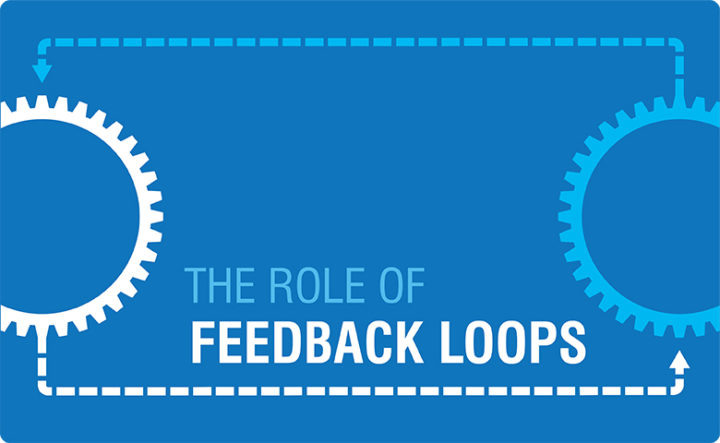
As mentioned above, it's helpful to commencement change with a small project. But this should be preceded by letting anybody know that the organization is not tackling a large project to begin with because it needs to get good at modify first. Starting minor volition let anybody get accepted to what the new alter management arroyo feels like and how it works.
Information technology might also exist a practiced thought to commencement with a safety initiative. It will demonstrate that the company cares about employees. This will build trust and engagement, and assistance all future change initiatives go more smoothly. Nonetheless, some people have a tendency to doubt new initiatives, specially when no serious incidents have happened to make them want change. "This is how we've always done it" or "we don't need more safety grooming" can exist a common refrain. Helping people come across prophylactic equally an urgent matter is important. This is where leaders come up in.
Adept managers know that change doesn't just happen and information technology can't simply be announced. For information technology to be successful, employees accept to be invested in the change and supported by leaders that display emotional intelligence and agreement. No system should forget the importance of leaders and feedback loops, especially in projects involving alter.
Considering how people react to modify and planning for their emotional needs alee of time can allow organizations to predict and deal with delicate and challenging bug quickly and successfully. Whether they're already on lath or still resisting change, employees demand their superiors to support, educate and atomic number 82 them towards the new status quo in a respectful and understanding manner. To know where employees are culture- and attitude-wise takes dedicated and caring leaders who know that change is often hard but are committed to making it easier on their teams.
Supervisors and leaders are the key to organizational comeback. With the correct skills, supervisors and leaders can place where the interactions between the workers and the systems diminish appointment, subtract productivity and affect run a risk levels. They tin can then support and get together information from individuals before communicating it upward and contributing to organizational growth and development.
To be successful, any organization needs to constantly acquire from its results and consider more than just systems and processes. Proficient leaders will recollect the effects that individual employees' physical and mental states (i.e., human factors) have on visitor operation and safe.
Figuring out how to handle workplace operations and safety by learning from the homo factors requires a system of advice that moves up and down in the organisation and also laterally across departments. Yous need well-trained and respected leaders for that.
Additionally, in that location needs to be a constant flow of inputs from the CEO, alter management and new systems teams likewise equally outputs from workers and supervisors to the corresponding teams (safety, change team, direction, and others). If organizations have a skillful framework in identify for multi-directional communication and feedback loops, they could accept inputs and outputs that are able to handle multiple subjects at the same time.
The importance of human factors
Alter is all about human factors. If you're implementing a new system, change management will have to focus on the people using the new system, so you need to business relationship for natural homo responses.
Organizations take to understand that in the midst of change, people are likely to be operating with reduced efficiency. Learning new information while trying to run into regular targets will likely cause rushing equally workers try to complete tasks they previously finished faster. Change will besides mean more stress, frustration, fatigue and then the crossover of those states to other people. This tin touch on performance and safety as well equally the change implementation schedule.
If supervisors don't empathise homo factors, they could unintentionally but inadvertently cause problems with the change initiative and fifty-fifty cause loss of appointment or increase the risk of injury amidst employees.
Human factors also affair when it comes to the difference between individual change and organizational change. The two are closely linked, and knowing how 1 affects the other tin help organizations a great deal. This is non but true inside the organizational framework and feedback loops, but also through the uncomplicated connection of teaching employees how to build habits and improve on their own. If they are comfy with such skills, they will exist more probable to arrange to organizational modify.
Constructive change
At that place is a difference between modify management every bit a projection-based challenge and a continuous comeback mindset. But to exist adept at projection-based, one-off changes, it might be worth learning about making your organization open up to modify in general. An approach that celebrates an improvement mindset (based in a strong organizational framework) will e'er be helpful, whether the changes down the line are small, large or continuous.
Any the reasons behind modify—safe, growth, mergers, new technologies—organizations need to consider a number of factors before they draft a plan. First with an cess of your electric current state and develop a articulate motion-picture show of your desired hereafter state. Remember that the rationale for change has to be strong.
Secondly, communication is always key. It's difficult to over-communicate, merely it's certainly common to not communicate enough. Leaders have to remember to clearly and repeatedly share their vision not only to continue people informed and remind them of what'due south at stake just likewise to keep them motivated. Equally important is the need to have information flowing in all directions, specially from the workers up through their supervisor to the rest of the organization, including the alter projection squad. This step involves including all the right people and, apparently, creating a communication plan.
Thirdly, it's of import to remember to use soft skills, especially if change is especially stressful or destabilizing. This includes incentivizing people, non necessarily with rewards, simply past trying to make them encounter the modify as a desirable goal.
Lastly, organizations need to consider their resources—human and otherwise—wisely and make sure they're appropriately managed. New equipment will be worthless if the employees don't know how to use it well or don't have the time to learn to. And no corporeality of safety training volition go along people prophylactic if their schedules require them to rush.
Change is never piece of cake and the larger the grouping affected, the more complex and lengthy the implementation. And information technology becomes fifty-fifty more complex and stressful when employee health and safety is on the line. Choosing the right change direction plan is of import, and proceed in listen that alter and improvement demand to exist entrenched in real care for employees and their families.
Source: https://safestart.com/news/which-change-management-model-is-the-best-for-your-organization/
Posted by: phillipsnobjess76.blogspot.com


0 Response to "How To Handle Change In An Organization"
Post a Comment